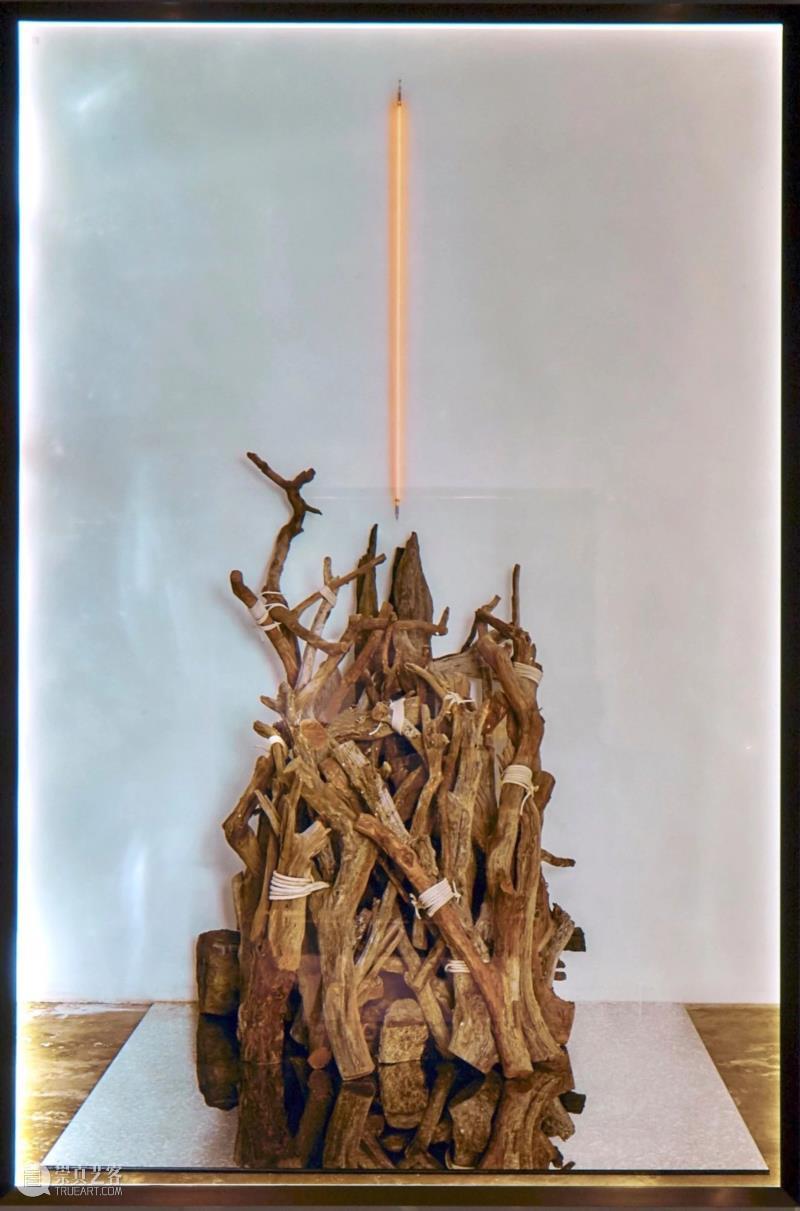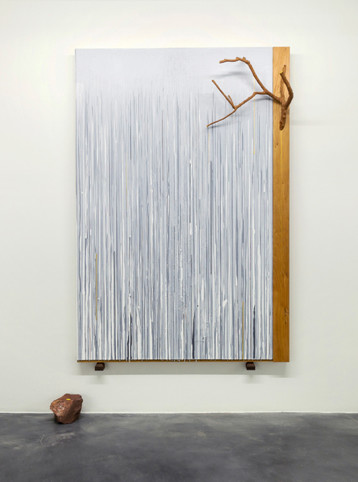
A bundle of longan branches sits on a fragmented mirror; a vertical neon tube dangles in the air like a sword of Damocles with a red, fluorescent glow — this is Chen Yufan's 2016 installation, Driftwood. Yet the "driftwood" in the lightbox does not sit right in front of us; it is a re-presented image, a reflection of another reflection.

Driftwood
Mixed media, lightbox, 180 x 120 cm, 2016
(Image courtesy of the artist)
In Chen's work, the longan branch is taken as a symbol of his hometown. Born in Putian, Fujian Province, the artist often uses materials of opposing qualities to evoke a sense of detachment or nostalgia.
Chen's hometown has the second-largest migrant population in Putian. Having moved from Putian to Fuzhou, Fujian Province to pursue his study, and later to Hangzhou and Shanghai while constantly going on long-term travels for exhibitions, Chen considers migration to be an important theme in his life trajectory so far. During festival celebrations when he and people from his hometown would gather, they seem to share a temporary "axis" like how the driftwood or logan branches are closely tied together.
 Driftwood
Driftwood
Mixed media, lightbox, 180 x 120 cm
Mat: 180 x 180 cm, 2016
(Image courtesy of the artist)
In an interview, Chen said: "Nostalgia is not about specific things but an abstract concept. However, concrete things in our memories evoke sentiments. I like to pull out the specifics from daily lives and make them re-appear in my works." (Quoted in "Chen Yufan speaks the anxiety for 20 million 'wanderers' " by Liu Xia)
The intuitive, inconsistent feeling of nostalgia may refer back, as Kim Sawchuk puts it, to a specific time or space in an “irrecoverable past,” which is then transformed into the recurring materials in Chen's works.

Origin
Iron, industrial neon light
90 x 90 x 138 cm, 90 x 90 x 90 cm
"Pal(ate)/ette/," SGA, Shanghai, 2019
In addition to wood, which is a ubiquitous element in Chen's works, the neon tube is undoubtedly another important symbol. In contrast to the longan branch, which represents the idea of "origin" or "home," the glowing tube, bent or straight, comes from urban space. In Driftwood, the suspended neon tube is stable and minimalist, like an artificial light belt that penetrates the mist between skyscrapers. The light represents a realistic aspect that transcends fragments of specific memories.
In Origin, purple-red and gold-colored neon tubes are bent into the shape of a flame, and the cold neon seems to obtain certain warmth that bridges the point of "rupture" in time and space, creating a dialog with life episodes buried deep in the past.

Landscape
Mixed media acrylic on canvas, coal,
steel wire, natural crystal
Variable size of hanging part, 2010-2012
(Image courtesy of the artist)

Landscape (Detail)
(Image courtesy of the artist)
The materials and forms that Chen repeatedly uses create certain intertextuality in his works. The coal chunks and crystal rocks in Landscape are purposely hung up with wires to form a "floating landscape," which contrasts with the context of "root" or "soil" that the natural materials normally evoke. The verticality of the work — formed by the repetition of the fine wires and dripping pigments — connects and balances with a feeling of instability. The contracts in Chen's works reflect the artist's individualized thinking of a space-time uncertainty, which is indeed full of doubts and contradictions. As Helmut Illbruck puts it, nostalgia is “a sentimental ideal, an imaginative, philosophical, or psychiatric paradox."

Uncertain Landscape - Early Autumn
Acrylic and mixed media on canvas, longan branch,
old elm, mineral stones, 195 x 130 cm, 2016 - 2017
(Image courtesy of the artist)
In Uncertain Landscape - Early Autumn, Chen discusses the forming and retaining of memory by documenting how the pigments randomly run and accumulate. Time flows in a way that cannot be easily concretized, yet it indeed changes and reshapes everything we are used to and that surrounds us. The familiar elements (longan branches, rocks) recur in Chen's works — they are stories that constantly replay in the artist's consciousness. In the face of modernity's universal invasion of people's lives, and in moments where people forget faster than memories are retained, those familiar images are perhaps the only remembrance of “our unpolluted child’s soul" (quoted from Henry van de Velde).

Chen Yufan, Chen Yujun, Mulan River - Voyage
Composite plate, cedar wood, bamboo, cedar wood shavings,
rosewood, wenge, old elm, Thailand rosewood,
rosewood shavings, longan branches
Variable dimension, 2017 - 2018
(Image courtesy of the artist)
Written by Cindy Zhu
References:
Hu Tingting, "Reconstructing fragments of memory: 'Chen Yufan' in the eyes of Chen Yufan"
Li Xuhui, "The 'wooden' world of Chen Yufan"
Liu Xia, "Chen Yufan speaks the anxiety for 20 million 'wanderers' "
Lu Mingjun, "The folding time: experiments and making of Chen Yufan's work"
Helmut Illbruck, Nostalgia: Origins and Ends of an Unenlightened Disease
Henry van de Velde, “Du paysan en peinture,” L'art moderne (22 February 1891)
Kim Sawchuk, Antimodernism and Artistic Experience: Policing the Boundaries of Modernity
Chen Yufan was born in 1973 in Putian, Fujian Province. In 2007, he graduated from the China Academy of Fine Arts with a general Arts degree. His most important exhibitions in recent years include: Chen Yufan (Ginkgo Space, Beijing, 2016), White: Chen Yufan and Chen Yujun (Tang Contemporary Gallery, Hong Kong, 2016), The Boundaries of Order (Hive Center for Contemporary Art, Beijing, 2015), The World III in the Third World (Chulalongkorn University Art Center, Bangkok, 2014), Mulan River – Unsettled (Galerie Queen Anne, Leipzig, 2013), ON|OFF: China’s Young Artists in Concept and Practice (Ullens Center for Contemporary Art, Beijing, 2013), FUCKOFF 2 (Groningen Museum, Groningen, 2013), The Folding Time – Chen Yufan’s New Works (Aye Gallery, Beijing, 2012), and Ctrl+N– Non-linear Practice Special Exhibition at the Gwangju Biennale (Gwangju Museum of Art, Gwangju, 2012).
Articles You May Like:
"Aftermath" | What would the world look like if humans vanished?
An open ending | Gao Weigang talks about his new exhibition
Between presentable and inexpressible | Artist Talk: Michael Joo
“I need to be alone so that I can work” | Tóibín x Shi Zhiying

Click to view the current exhibition:"AFTERMATH"
(On view through Jan.15th, 2020)


已展示全部
更多功能等你开启...






 分享
分享